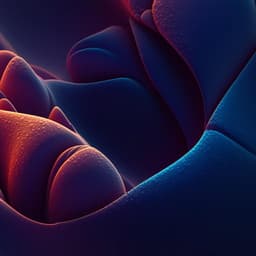
Physics
Topologically protected vortex knots and links
T. Annala, R. Zamora-zamora, et al.
This groundbreaking research by Toni Annala, Roberto Zamora-Zamora, and Mikko Möttönen explores the fascinating world of non-Abelian vortex knots and links that are topologically protected. Unlike traditional structures that can easily unravel, these knots remain intact under local reconnections, showcasing a fascinating classification scheme based on topologically allowed transformations. Discover the implications of these findings across various physical systems, including Bose-Einstein condensates and liquid crystals.
Playback language: English
Introduction
Lord Kelvin's 1869 hypothesis that atoms were knotted vortices in an ether, while incorrect, spurred advancements in knot theory and the study of knotted structures in physics. However, previous research showed that knotted vortex structures can untie via local reconnections and strand crossings. This paper addresses the fundamental question: Can topologically protected vortex knots and links be created, where untying is prevented by the underlying physics? The authors introduce a class of knotted structures composed of non-Abelian topological vortices, which are codimension-two defects in an ordered medium where the order parameter's winding about the vortex core corresponds to a non-trivial element of the fundamental group. Non-Abelian vortices, where the fundamental group is non-Abelian (such as the quaternion group Q8), exhibit unique behavior; for instance, vortices corresponding to non-commuting group elements cannot freely pass through each other. The study uses colored link diagrams to represent vortex configurations, incorporating the group structure of the order parameter space. This approach considers evolution through core crossings and reconnections, providing a more physically relevant description than previous isotopic evolution studies.
Literature Review
Numerous physical systems exhibit knotted structures, including liquid crystal disclination lines, vortex cores in superfluids and other media, DNA strands, Skyrmion cores, and quantum knots in Bose-Einstein condensates. Deep connections exist between knot theory and statistical mechanics, topological quantum computing, and quantum field theories. Mathematically, knots and links are closed loops and their configurations in 3D space. The robustness of physical knots lies in the fact they cannot be untied without cutting; similarly, vortex knots in ideal fluids remain knotted due to conserved helicity. However, dissipation can cause spontaneous untying through local reconnections. Previous studies on topological vortices have focused on isotopic evolution, neglecting the possibilities of core crossing or reconnection. This paper significantly departs from previous work by incorporating core-topology altering events (crossings and reconnections) into the stability analysis.
Methodology
The methodology involves several key steps:
1. **Identifying Topological Vortex Configurations:** The authors begin by identifying topological vortex configurations for physically relevant order parameter spaces using colored link diagrams. These diagrams represent the spatial arrangement of vortex cores and the associated order parameter winding. Figure 1 illustrates the Wirtinger presentation of the fundamental group of the link complement and how colored link diagrams represent the group homomorphism from the fundamental group of the link complement to the fundamental group of the order parameter space. Figure 2 shows a graphical depiction of Q8-colored link diagrams for topological vortex configurations in specific physical systems.
2. **Defining Rules for Core-Topology-Altering Evolution:** The paper outlines rules governing how the core topology of the vortex structures can change. These changes are limited to topologically allowed local reconnections and strand crossings. Figure 3 depicts core-topology-altering local modifications, including strand crossings (only between strands of the same color or if at least one strand is purple) and local reconnections (only between strands of the same color, respecting bicoloring continuity).
3. **Developing and Applying Invariants:** To establish topological stability, the authors utilize invariants of Q8-colored links. The linking invariant I (an element of Z2) counts the number of times a blue strand crosses over a red strand, modulo 2. This invariant is conserved under topologically allowed transformations. A more refined invariant, the Q-invariant (valued in Z4), is defined in Figure 6. It involves multiplying quaternions associated with undercrossings of loops of a chosen color, considering the self-writhe of the loop. The Q-invariant also proves to be conserved under allowed transformations. Figure 6 defines the Q-invariant, calculated using loops of a single color. The computation uses a-invariants of loops. Figure 7 illustrates the sign of crossings and calculation of self writhe. Figure 8 gives examples of a-invariants and colored invariants (Q) of Q8-colored links.
4. **Classifying Q8-Colored Links:** The authors classify Q8-colored links up to reconnections and strand crossings, leveraging the developed invariants. This results in a surprisingly small number of distinct classes (Figure 4). The authors also consider the classification of links by applying Reidemeister moves, illustrated in Figure 9. The paper demonstrates the conservation of the colored invariants Q under topologically allowed strand crossings (Figure 10) and reconnections (Figure 11). The classification of Q8-colored links is further developed using Milnor's classification of three-component links (Figure 12), the surgery operation illustrated in Figure 13a, and other relevant methods described in the paper. Figure 13 summarizes the classification of Q8-colored links.
5. **Considering Physical Systems:** The study identifies specific physical systems where these topologically protected vortex configurations can exist. These include the cyclic or biaxial nematic phases of spin-2 Bose-Einstein condensates and the biaxial nematic phase of liquid crystals. The fundamental groups of the order parameter spaces in these systems contain Q8 as a subgroup (Methods section).
Key Findings
The key findings of the paper are:
1. **Existence of Topologically Protected Vortex Links:** The authors demonstrate the existence of topologically protected vortex knots and links. These structures are robust against untying via local reconnections and strand crossings, a phenomenon not observed in previous studies of knotted vortices.
2. **Invariants for Classification:** The paper introduces and utilizes invariants (linking invariant I and Q-invariant) to classify these topologically protected structures. The Q-invariant provides a more refined classification than the linking invariant.
3. **Simple Classification Scheme:** Despite the complexity of the underlying topology, the proposed classification scheme for Q8-colored links based on topologically allowed transformations yields a remarkably simple classification: only six non-trivial Q8-colored links exist (up to allowed transformations), and 16 trivial links (Figure 4).
4. **No Topologically Protected Knots for Q8:** The study reveals that systems described by the quaternion group Q8 cannot support topologically protected vortex knots (only links); this is specific to Q8. However, the authors demonstrate the existence of topologically protected knots for other groups (such as the permutation group S3, Figure 4c), showing that the non-existence of topologically protected knots is not a general result.
5. **Physical Realizability:** The authors demonstrate the potential for physical realization of these topologically protected structures in several condensed matter systems (spin-2 Bose-Einstein condensates and specific liquid crystal phases), suggesting directions for experimental validation. The paper provides a detailed analysis of the order parameter spaces of these systems and shows that the fundamental groups of these spaces contain Q8 as a relevant subgroup (Methods section).
6. **Decay of Colored Links:** Figure 5 illustrates that any Q8-colored link can decay into an unlink via topologically allowed reconnections, strand crossings, and vortex splittings. The paper notes that the assumptions made in the model (forbidding vortex loop disappearance, limiting vortex crossings to commuting elements, and excluding distant vortex splitting) are crucial for the existence of topologically protected links. These assumptions may hold in certain physical systems but not in others.
Discussion
The findings address the research question by demonstrating that topologically protected vortex structures exist under specific conditions. The significance lies in the discovery of robust knotted structures that resist untying through common mechanisms (local reconnections and strand crossings), expanding our understanding of topological defects in condensed matter physics. The simplicity of the classification of Q8-colored links is surprising and suggests potential applications in areas such as topological quantum computing. The identification of specific physical systems where these structures are realizable opens avenues for experimental verification and exploration. The limitations of the model, particularly the assumptions regarding vortex dynamics, need consideration when interpreting the results and extending them to other systems. Future research should investigate these limitations further, explore the dynamics of these structures using simulations, and explore the possibility of creating and observing these structures experimentally.
Conclusion
This paper makes significant contributions by identifying and characterizing a class of topologically protected vortex knots and links. The authors introduce novel invariants and develop a classification scheme, resulting in a surprisingly simple categorization of these structures. The study suggests exciting directions for future research, including experimental verification of these structures in the proposed physical systems, developing similar classifications for other physically relevant groups, and investigating the dynamics of these structures through numerical simulations. The preparation of such structures is a challenge, requiring exploration of methods beyond local tailoring, potentially employing rapid phase transitions or controlled external field manipulation.
Limitations
The model makes specific assumptions regarding vortex dynamics, including the prohibition of vortex loop disappearance via shrinking, the restriction of vortex crossings to commuting elements, and the exclusion of distant vortex splitting. These assumptions are crucial for the existence of topologically protected structures, but may not hold universally across all physical systems. The generalizability of the findings to systems that violate these assumptions remains to be investigated. Furthermore, while the existence of topologically protected knots for groups other than Q8 is demonstrated, the paper does not delve into the detailed physical systems that could support such structures.
Related Publications
Explore these studies to deepen your understanding of the subject.







